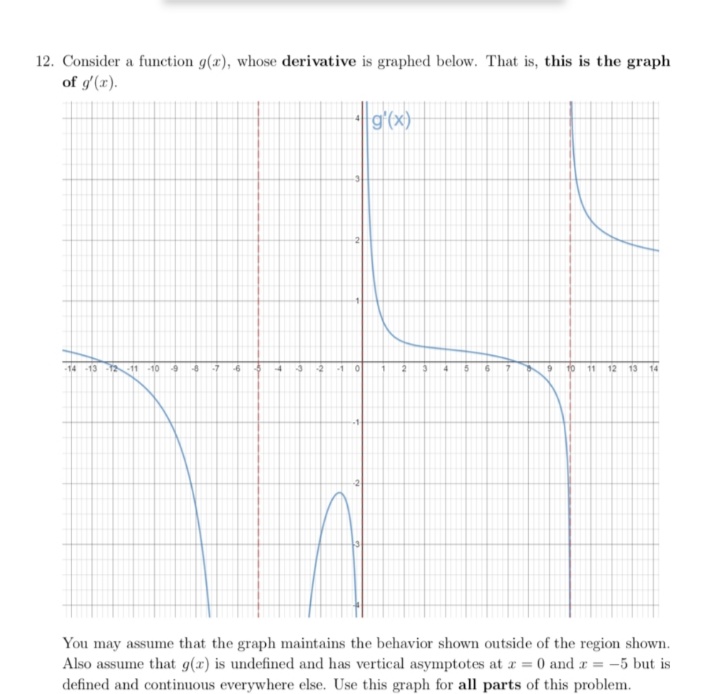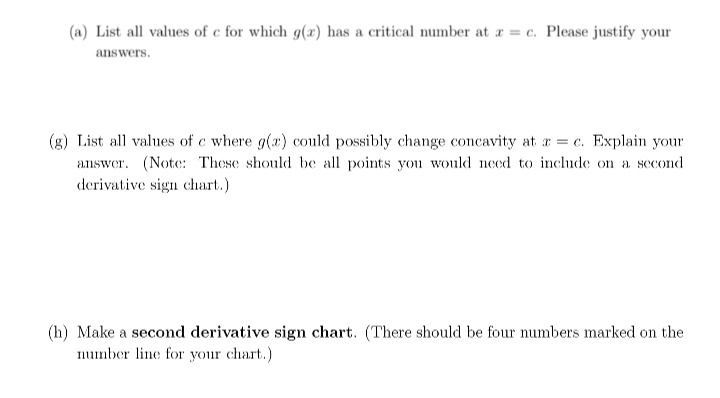12. Consider a function g(r), whose derivative is graphed below. That is, this is the graph of g'(x). g'(x) 14 13 11 10 10 11 12 13 14 You may assume that the graph maintains the behavior shown outside of the region shown. Also assume that g(r) is undefined and has vertical asymptotes at a 0 and r = -5 but is defined and continuous everywhere else. Use this graph for all parts of this problem.
12. Consider a function g(r), whose derivative is graphed below. That is, this is the graph of g'(x). g'(x) 14 13 11 10 10 11 12 13 14 You may assume that the graph maintains the behavior shown outside of the region shown. Also assume that g(r) is undefined and has vertical asymptotes at a 0 and r = -5 but is defined and continuous everywhere else. Use this graph for all parts of this problem.
Calculus: Early Transcendentals
8th Edition
ISBN:9781285741550
Author:James Stewart
Publisher:James Stewart
Chapter1: Functions And Models
Section: Chapter Questions
Problem 1RCC: (a) What is a function? What are its domain and range? (b) What is the graph of a function? (c) How...
Related questions
Question
100%

Transcribed Image Text:12. Consider a function g(x), whose derivative is graphed below. That is, this is the graph
of g'(x).
gʻ*x)
g'(x)
14 -13 111
-10
-9
-7
-10
to
11
12
13
14
You may assume that the graph maintains the behavior shown outside of the region shown.
Also assume that g(x) is undefined and has vertical asymptotes at z = 0 and r = -5 but is
defined and continuous everywhere else. Use this graph for all parts of this problem.

Transcribed Image Text:(a) List all values of c for which g(x) has a critical number at r = c. Please justify your
answers.
(g) List all values of c where g(x) could possibly change concavity at a = c. Explain your
answer. (Note: These should be all points you would need to include on a sccond
derivative sign chart.)
(h) Make a second derivative sign chart. (There should be four numbers marked on the
number line for your chart.)
Expert Solution
This question has been solved!
Explore an expertly crafted, step-by-step solution for a thorough understanding of key concepts.
Step by step
Solved in 4 steps with 1 images

Knowledge Booster
Learn more about
Need a deep-dive on the concept behind this application? Look no further. Learn more about this topic, calculus and related others by exploring similar questions and additional content below.Recommended textbooks for you

Calculus: Early Transcendentals
Calculus
ISBN:
9781285741550
Author:
James Stewart
Publisher:
Cengage Learning

Thomas' Calculus (14th Edition)
Calculus
ISBN:
9780134438986
Author:
Joel R. Hass, Christopher E. Heil, Maurice D. Weir
Publisher:
PEARSON

Calculus: Early Transcendentals (3rd Edition)
Calculus
ISBN:
9780134763644
Author:
William L. Briggs, Lyle Cochran, Bernard Gillett, Eric Schulz
Publisher:
PEARSON

Calculus: Early Transcendentals
Calculus
ISBN:
9781285741550
Author:
James Stewart
Publisher:
Cengage Learning

Thomas' Calculus (14th Edition)
Calculus
ISBN:
9780134438986
Author:
Joel R. Hass, Christopher E. Heil, Maurice D. Weir
Publisher:
PEARSON

Calculus: Early Transcendentals (3rd Edition)
Calculus
ISBN:
9780134763644
Author:
William L. Briggs, Lyle Cochran, Bernard Gillett, Eric Schulz
Publisher:
PEARSON

Calculus: Early Transcendentals
Calculus
ISBN:
9781319050740
Author:
Jon Rogawski, Colin Adams, Robert Franzosa
Publisher:
W. H. Freeman


Calculus: Early Transcendental Functions
Calculus
ISBN:
9781337552516
Author:
Ron Larson, Bruce H. Edwards
Publisher:
Cengage Learning